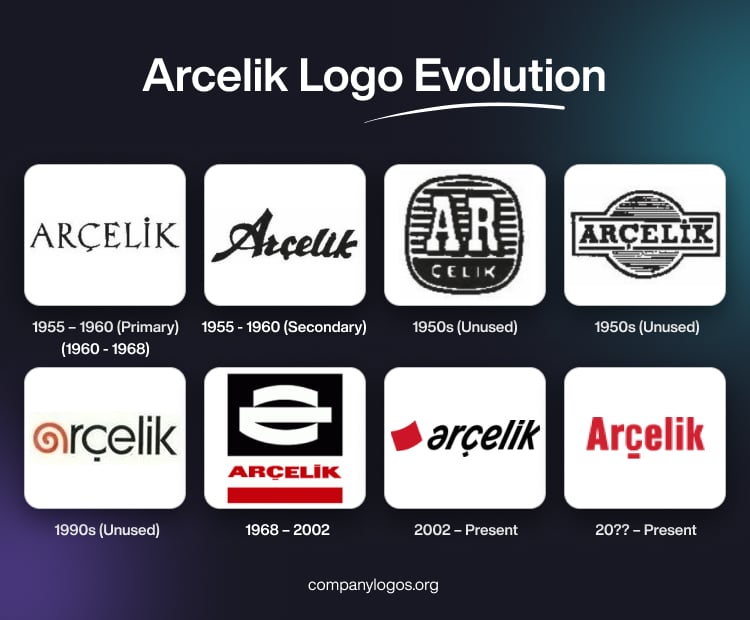
Arcelik is a Turkey-based brand of home appliances and consumer electronics and is the owner of the Beko and Grundig brands. Founded in 1955 as a small workshop for manufacturing electric motors and transformers, the company has come a long way. Today, it operates in more than 130 countries and is the recipient of several awards and accolades for its commitment to eco-friendly products and practices.
It is a subsidiary of Koc Holding, which is arguably the largest industrial group in Turkey. Its logo has undergone several transformations to reflect the journey of the company from a local manufacturer to a global leader. The article delves into the various logo changes of Arcelik, among other details of the company.
The Genesis of the Arcelik Logo (1955 – 1960) (Primary) (1960 – 1968)
The original logo design was straightforward and was limited by mid-century typographical and design standards. It featured the brand name in black and was written using a simple, thin serif typeface with basic geometric elements. Although the brand name was written in uppercase, the letter “I” had a dot above it. There was a tiny smudge below the letter “C”.

(1955 – 1960) (Secondary)
Another logo was designed during this period, which was tagged as secondary. It featured the brand name in a cursive title case and in thick black letters.
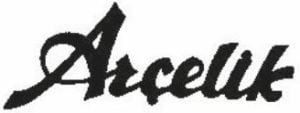
(1950s) (Unused)
A few logos were designed during the fifties, but they were never made official. The first one featured a circle in monochrome containing the wordmark “ARCELIK” in two levels. The letters “AR” in white and in thick serifs with a black outline and shadows were placed against a bigger background that consisted of a series of alternate black and white stripes. The remaining letters of the brand name “CELIK” in white were placed below in a smaller size against a black background.
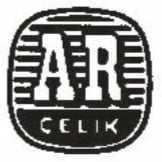
(1950s) (Unused)
Another unused logo during this period featured the brand name in black uppercase placed within a horizontal rectangle with a black outline and white background. The rectangle was further connected to a circle at the centre, having a series of black and grey stripes.
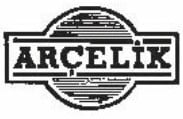
(1990s) (Unused)
The unused logo during this period featured the brand name written in a rounded sans-serif typeface in black. However, the letter “a” was depicted in red but in a spiral form.

(1968 – 2002)
Around 1968, Arçelik adopted a more stylised logo that featured a monochrome emblem and the wordmark in red uppercase. The emblem contained geometric elements in white that looked like two wide arcs at the top and bottom and a thick horizontal stripe in the middle – all pitted against a black square background. The red wordmark in a sans-serif typeface was placed below the emblem and above a thick horizontal stripe, also in red.
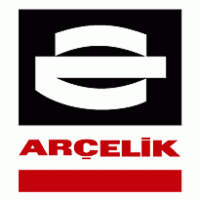
(2002 – Present)
The most recognisable version of the Arçelik logo appeared in 2002. It introduced the “Flex” concept, which has been derived from the dynamic transformation of the bent steel motif. This linked heritage as well as the layered meanings of flexibility and technological innovation for a global era.
The bent steel motif in red was followed by the brand name in black lowercase and written using a gently rounded and italicised sans-serif typeface. Interestingly, in the wordmark, the letters “a” and “e” looked like mirror images of each other.

(20?? – Present)
The present logo features the brand name in red title case against a red background. There is a tiny dash below the letter “c”, also in red.

The Elements of the Arcelik Logo
Font
The Arçelik logo features a custom lowercase sans-serif font to reflect modernity and approachability. The key characteristics of this font include gentle, rounded edges on each letter in lowercase to project friendliness and a modern outlook.
Colour
The signature colour of the Arçelik logo is vibrant red to convey energy and technological innovation. Besides, it symbolises Turkish national pride, as the colour forms a prominent part in the country’s flag and design aesthetics. The other colours donning the logo are black and white, which support minimalism and align with the global branding trends towards simplicity.
The History of Arcelik
Arçelik A.Ş. is a leading Turkish multinational that manufactures household appliances and electronics. It was founded in 1955 in Sütlüce, Istanbul, by Lütfü Doruk in partnership with Vehbi Koç as part of Turkey’s postwar industrialisation drive. The company quickly established itself as an innovator in the domestic market. For instance, it produced Turkey’s first washing machine and refrigerator in 1959 and 1960, respectively.
During the 1970s and 1980s, Arçelik expanded its manufacturing capabilities. It had set up new plants such as the Eskişehir Refrigerator Plant in 1975 and the Compressor Plant in 1977. In 1986, it was listed on Borsa Istanbul. And to undertake in-house technological innovation, it established the R&D Centre in 1991.
The early 2000s signalled a period of rapid globalisation for Arçelik, which was driven by both organic growth and strategic acquisitions. In 2002, it acquired Austrian Elektra Bregenz, German Blomberg, British Leisure and Flavel, and Romanian Arctic. This was followed by the 2007 acquisition of Grundig, a major German electronics brand.
Between 2011 and 2019, Arçelik expanded further into emerging markets with the purchase of Defy in South Africa, Dawlance in Pakistan, and Singer in Bangladesh. The company also formed notable joint ventures, such as with LG Electronics for air conditioners and the Tata Group in India for the Voltas Beko brand.
Arçelik operates over 15 production facilities in Turkey, Europe, Russia, China, Thailand, and South Africa. It has a brand portfolio that includes Arçelik, Beko, Grundig, Defy, Arctic, Blomberg, Leisure, Flavel, Altus, and Dawlance. Serving more than 130 countries, it is the market leader in Turkey, Romania (with Arctic), and South Africa (with Defy).
Known for innovation, Arçelik invests heavily in R&D. It runs an extensive network of research centres and has registered thousands of patents. It has also embraced sustainability through its philosophy “Respects the Globe, Respected Globally”, thereby earning global recognition for responsible manufacturing and technology leadership.
In recent years, the company has undertaken significant moves to strengthen its global standing. In 2021, it established Arçelik-Hitachi Home Appliances as a joint venture, and in 2024, it completed a major merger with Whirlpool EMEA to form Beko Europe. The latter is now the largest household appliance manufacturer in Europe by production volume. While the Beko brand increasingly represents Arçelik internationally, the Arçelik name remains a powerful symbol of quality and innovation in Turkey and selected markets.
Interesting Facts About Arcelik
- Arçelik was established in 1955 in Turkey by Vehbi Koç and Lütfi Doruk. It is arguably one of the country’s oldest and most influential household appliance manufacturers.
- Despite being a Turkish brand, Arçelik operates in over 150 countries and owns more than 20 international brands, which include Beko, Grundig, Blomberg, Defy, and Arctic.
- Arçelik is part of Koç Holding, Turkey’s largest industrial conglomerate. It is ranked among the world’s top companies by Fortune Global 500.
- Through its subsidiary Beko, Arçelik is one of the top-selling home appliance brands in the UK and is also among Europe’s leading appliance manufacturers.
- Arçelik has more than 30 R&D and design centres worldwide and holds over 3,500 international patents.
- The company has been recognised for its eco-friendly initiatives. These include producing energy-efficient appliances and aiming for net-zero emissions in operations by 2050.
- Arçelik has received several prestigious awards, including Energy Star Partner of the Year (through Beko USA) and design accolades from Red Dot and the iF Design Award.
- Arcelik is one of the first companies in Turkey to establish a Waste Electrical and Electronic Equipment (WEEE) recycling facility to process old appliances into reusable materials.
- Arçelik manufactures everything from refrigerators, washing machines, and dishwashers to small kitchen appliances, televisions, and air conditioners.
- Much of Arçelik’s expansion came from acquiring foreign brands, which enabled it to adapt to different regional markets while maintaining a global supply chain.
Finally
The Arçelik logo and its various iterations have evolved over the years to become an emblem of Turkish ingenuity. These combine local symbolism with international design trends. The logo journey continues unabated as the company leads the way in technological innovation and sustainability.